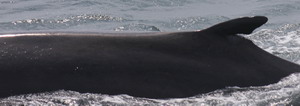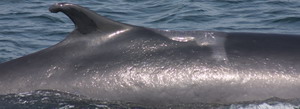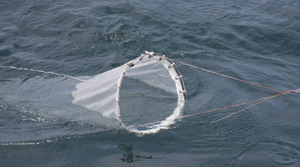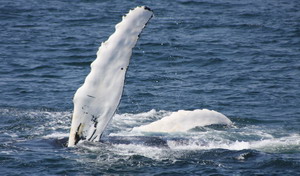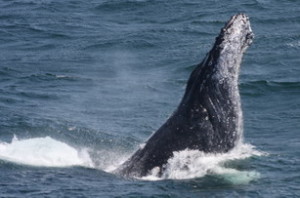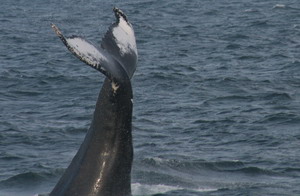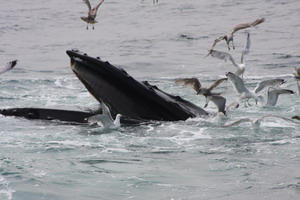Dolphin Fleet Naturalist Notebook 28 June to 4 July
We awoke on June 28th to find calm seas and bright, albeit hazy skies. However, once we passed Race Point Light on the northern tip of Provincetown, we found ourselves socked-in by heavy fog. Because we rely on our eyesight more than anything else to find whales on these trips, fog presents a challenge. We cruised slowly along the north and eastern shorelines of the Cape, where fin whales had been spotted the previous evening and we listened carefully for the powerful exhalation of one of these animals. Several boats managed to locate fin whales by simply listening, and the mid-day trip on the Dolphin VII even managed to find them lunge feeding. With visibility decreasing as the day went on, we hoped for clearer skies in the following days.
By June 29, the fog still sat stubbornly over the Cape, but visibility had increased and our boats had a little more luck in finding a number of both humpback and fin whales. During the past few years, Dolphin Fleet naturalists have been trying to become more familiar with individual fin whales. Dolphin Fleet naturalist John Conlon has been particularly dedicated in putting together a comprehensive catalog composed of fin whales seen frequently in the Southern Gulf of Maine. Today, thanks to his efforts, we were able to use the catalog to identify three different individuals, including Spike, Amp, and Loon. In the photos below, note the drastic differences in the size and shape of their dorsal fins.
Amp Loon
Spike
By identifying individual animals, we hope to learn more about the population as a whole. Fin whales can be observed in the waters surrounding Cape Cod all year long, but are they the same individuals? Do they migrate, and if so, where? There is so much that we have yet to learn about these mysterious creatures.
On June 30th we headed back east to where we had such good luck the previous day. Sure enough, fin whales and humpback whales were abundant off of Peaked Hill in Provincetown, where the steep drop-off from land offers an ideal vertical edge along which upwellings can occur and nutrients can be circulated. The calm, flat seas provided a perfect opportunity for us to drop the plankton net into the water on the morning trip.
Even though most of the whales that we see during the summer season are here to feed on small schooling fish, it is helpful to understand what these fish are feeding on to understand why they are there. Many of the small schooling fish that provide our whales with nutrients get their food in the form of zooplankton. Zooplankton is a term that encompasses any animal that sits suspended in the water column and that drifts along with the current. Zooplankton might swim up and down in the water column, sometimes at remarkable speeds, but its long range movements are largely determined by the movements of the water.
Today, our net captured a number of copepods–small crustaceans about the size of a flea which are the favorite food of a diverse array of species, including the sand lance, the Wilson’s storm petrel, and the critically-endangered North Atlantic right whale. During the winter, local scientists sample this type of plankton regularly to try to predict the movements of the right whale within the Cape Cod Bay feeding ground. Examining our plankton sample under the boat’s microscope, we remarked at how incredible it was that such a tiny critter could play such an enormous role in our marine ecosystem.
By the morning of July 1, the haze remained and our whales had moved north. Amp, our fin whale from Sunday, was sighted again on the morning trip, this time swimming in wide, deliberate circles. This circling is characteristic of feeding fin whales and it is thought the whales are essentially corralling schools of fish. After leaving the fin whale in search of some humpbacks, we found just what we were looking for. Ragweed, a humpback whale, delighted Dolphin VII passengers by breaching!
The fin whales continued to feed throughout the day, frequently circling and lunging, but sometimes even rolling over completely. When fin whales feed, they will sometimes roll 90 degrees to one side with their mouths open. This maximizes the amount of fish that they can take in, particularly if those fish are schooling near the surface.
On July 2, the Dolphin VI started the day by stopping on a mother and calf pair logging at the surface. Logging is a presumed resting behavior for humpbacks and simply refers to the fact that when humpbacks float, nearly motionless, at the surface, they resemble giant logs. Suddenly, the calf became restless and began rolling around on its side, sometimes almost appearing to whack its mother with its flipper!
Soon, we saw another flash of white on the horizon, and as we approached, we found Aerospace, another humpback, rolling around and flipper slapping. We don’t know what causes these humpbacks to do this, but often one flipper-slapping humpback triggers a chain-reaction of flipper slapping and breaching throughout the area, which is precisely what happened today. Soon, flashes of white and sudden bursts of spray were visible as far as they eye could see.
Passengers aboard the evening trip were treated to the sight of an approaching thunderstorm. Before it began to rain, we could see the vertical stripes left by the falling water droplets. Mark, one of our naturalists, remarked that as the Dolphin VII left Cape Cod Bay, “the sky darkened with the approaching storm and lightening laced the sky.” Whale watchers were still able to see the whales continue to breach, or jump, and finally, the sky was framed by a double rainbow. Even after over 20 years of whale watching, Mark remarked that trips like these really put the world in perspective.
By July 3, visibility had increased, but the winds had picked up significantly, and continued to blow throughout the day. For some reason, rough seas can lead to very active surface behavior from our humpback whales, and that is exactly what happened today. On the Dolphin VIII’s midday trip we headed Northeast towards an area known as “The Triangle” where we came across a breaching humpback whale calf. Its small size and hazy fluke pattern indicated that this whale could be no more than 6 or 7 months old, but as we looked around, its mother was nowhere to be found. Eventually, we saw a larger whale in the distance. That must be mom! Perhaps the calf was making such a ruckus to get its mother’s attention. The calf continued to breach and chin breach in the direction of its mother, but the rough seas made progress slow. By the time we had to go in for the day, the pair had not reunited. We assured concerned passengers that humpback whales are very acoustically oriented and will certainly use loud “whoops” and other calls to relocate one another eventually.
On the evening trip, we found ourselves off of Highland Light in Truro, dazzled by a trio of feeding fin whales. As one of these fin whales lunged through a school of fish, it repeatedly rolled completely over, displaying it’s bright white belly, which looked like a big green torpedo racing through the water. Fin whales display a pigmentation pattern called “counter-shading” which is typical of cetaceans. Their white bellies make them difficult to see from below, as they blend in with the sky, while their darker dorsal sides make them blend in with the dark colors of the sea. Associated with the fin whales were a number of Cory’s Shearwaters, which are gull-sized pelagic birds that migrate to the cold, nutrient-rich waters of the North Atlantic to feed on the same small schooling fish as the whales. See this week’s bird update for more information on birds seen in Stellwagen Bank this week.
The trip ended dramatically with Division and her calf. Division’s calf was breaching away, but we were all taken aback as Division launched herself out of the water, creating a towering splash that her calf couldn’t come close to matching. The seas continued to pick up and the approaching sunset meant it was time to go home, but we received a beautiful send off as Division and her calf lobtailed until we could just barely see the splashes on the horizon behind us.
July 4 was a day of feeding lessons for some of our mother and calf humpback whale pairs. Mike, our naturalist on the Dolphin VIII remarked that Division was kickfeeding while her calf was blowing bubbles and lunging at the surface, though not usually through the bubbles, with its mouth wide open. The calf would usually follow this with a tail breach. Meanwhile, on the Dolphin VI, naturalist Nancy noted the very same behavior with Scylla and her calf. Scylla’s calf would lunge through bubble clouds with her mouth wide open!
Division kicks and lunges
One of the benefits of recognizing individual animals is that we get to see calves learn and grow throughout the season. Feeding can require a lot of coordination and these calves are clearly learning from their mothers’ examples before they have to go off and do it on their own a few months from now.






